Furman Engaged invites us to explore new places, topics, questions and cultures
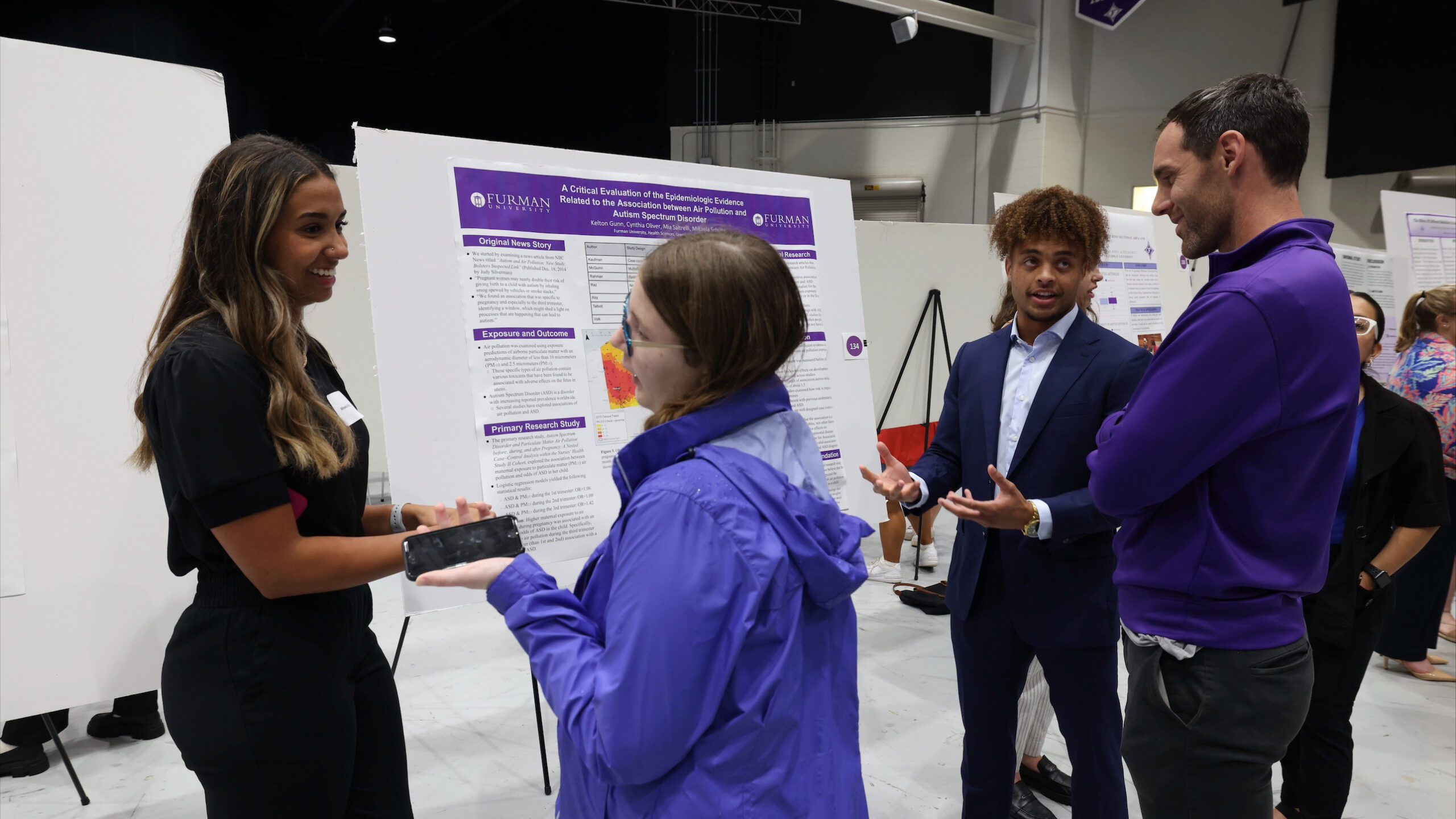
Where can you sample Kazakh piroshki, listen to a podcast about student-athletes and explore the socio-political and historical context of French architecture? At the 15th annual campus-wide celebration of engaged learning, known as Furman Engaged.
During this Furman tradition, students share their research, internships and study away, among other scholarly and performance activities. On April 13, the day before Furman Engaged, students presented their entrepreneurial ideas during the Paladin Pitch Competition, hosted by The Hill Institute for Innovation and Entrepreneurship. These events, in addition to the Furman Showcase, featuring faculty presentations on Saturday, April 15, are part of the launch weekend for Clearly Furman, The Campaign for Our Third Century.
Meanwhile, Friday’s Furman Engaged featured about 550 students making 700 presentations to their peers, faculty, staff, employers, alumni and the broader community. Here are just a few of the other immersive opportunities that Furman students shared during Furman Engaged.
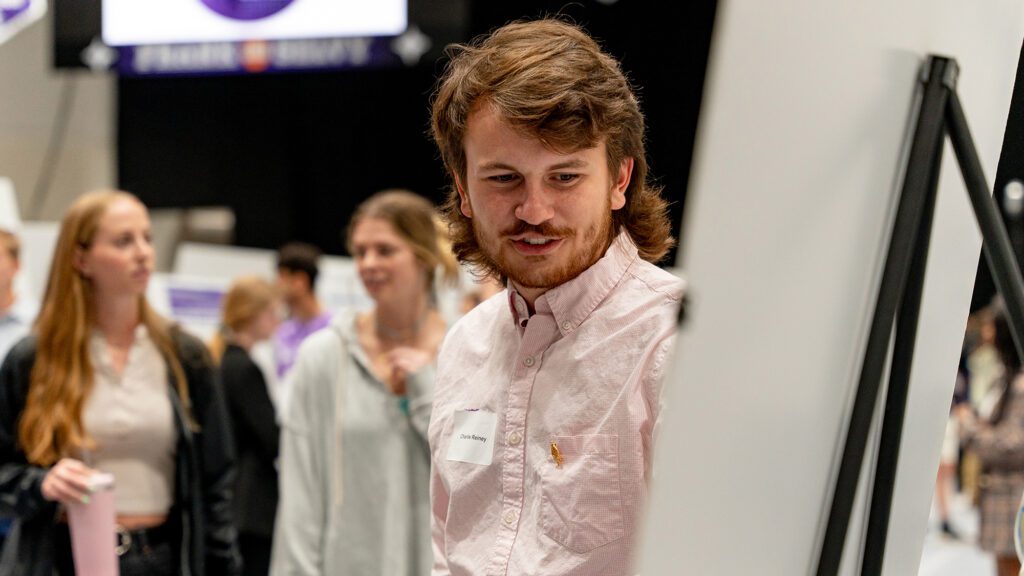
Charlie Reiney ’23 discusses his poster inside Timmons Arena.
6,000 ticks
For some of us, ticks are a nuisance while hiking. For African farmers, tick-borne diseases that strike livestock can be devastating to a family’s livelihood. Kaya Frawley ’24 traveled to a game reserve in the Limpopo Province of South Africa to learn how habitat and climate affect tick abundance and diversity. While on the reserve, Frawley dragged a pole draped with cloth across three different types of habitat to collect and identify ticks: 6,000 of them in all.
In Africa, 37% of land mass is made up of farms, which produced 70% of continent’s food supply. In the 1980s, scientists started to encourage the use of acaricides, a kind of pesticide, on their farms, which decreased tick infestation. But Frawley said a resistance to acaricides has emerged, which makes it less effective against the arachnids. Her recommendation is to go back and closely examine the multitude of ecological relationships involving ticks to develop better tick-control methods.
“Tick-borne diseases can have local, national, continental effect,” she said, adding that they decrease livestock reproduction and milk production and raise mortality rates. Eco-tourism and game ranching are also affected.
The cyclical nature of trauma
Caitlyn Horton, a student in the Master of Science in Community Engaged Medicine program, examined the existing research about the greater likelihood that women experiencing trauma – such as physical assault, intimate partner violence and childhood abuse – later experience homelessness later in life. These women have a greater risk of isolation, psychiatric disorders and hormonal imbalances, among other symptoms, she explained.
Horton studied public health at Rutgers University and had volunteered directly with women experiencing homelessness (WEH) in New Jersey. What became clear is that some of the women she worked with were not comfortable in a shelter.
“I think that’s the distrust that comes from trauma,” Horton said. So, she helped to provide them with mobile shower facilities – “Having that private space to themselves to get clean and to be in your own thoughts.”
Today Horton volunteers at Shepherd’s Gate shelter for women and children, participates in the Medical Legal Partnership, serves as a nursing assistant, and will apply to medical school this year. Horton recommends trauma-informed care and communication among professionals who support WEH and examining sources of trauma to better design responsive resources, among other measures.
“Having childcare resources, addiction treatment, domestic counseling – these are all things that will better serve this population.”
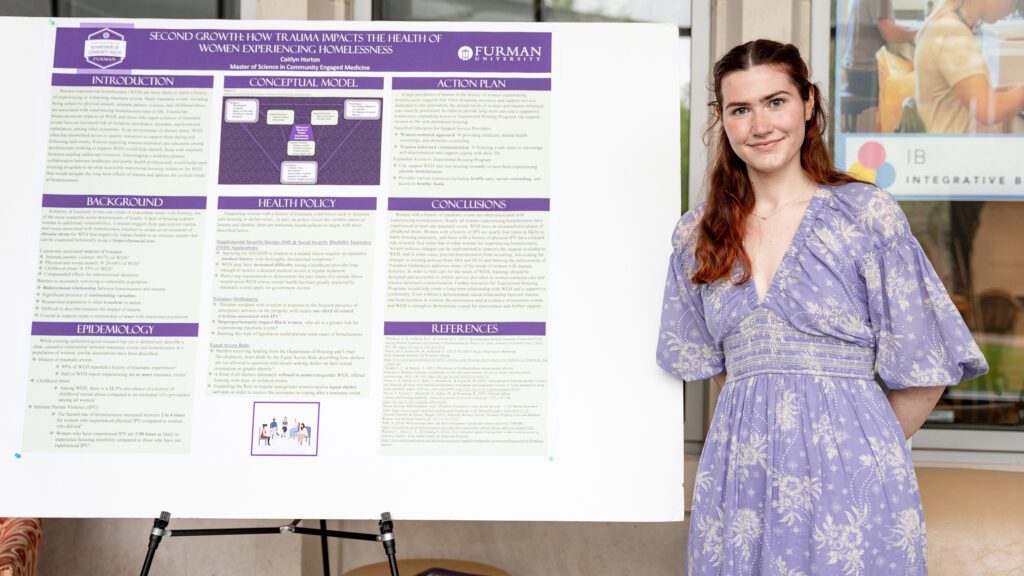
Caitlyn Horton, an MSCEM student, during Furman Engaged
‘Covering the Court’
In his podcast, “Covering the Court,” Elijah Poritzky ’25 explores how athletes’ sports shape them into the people they are today. Poritzky, a Furman tennis player, captured his interview with Jerry Barton ’26, a fellow tennis player, who was born in Dallas, Texas, but whose parents are from the Czech Republic and raised him to speak Czech first.
Poritzky, who used Adobe Audition, explained how recording a simple conversation relies on the technical skills to cleanly cut in the music he chose for the podcast before and after interview, reduce background noise and effectively fade in and fade out. Although “Covering the Court” refers to tennis, Poritzky said he’d like to expand it to include athletes from other sports. He pointed to a correlation between the subject of his podcast, tennis, and the process behind creative works.
“Not just in the podcast, but in other projects I’ve done, there are so many setbacks, and you lose footage and there are things that you think are not going to go your way, and you figure it out,” he said. “And that’s the same thing in tennis, you know. If it doesn’t go your way, you’re going to have to figure it out.”
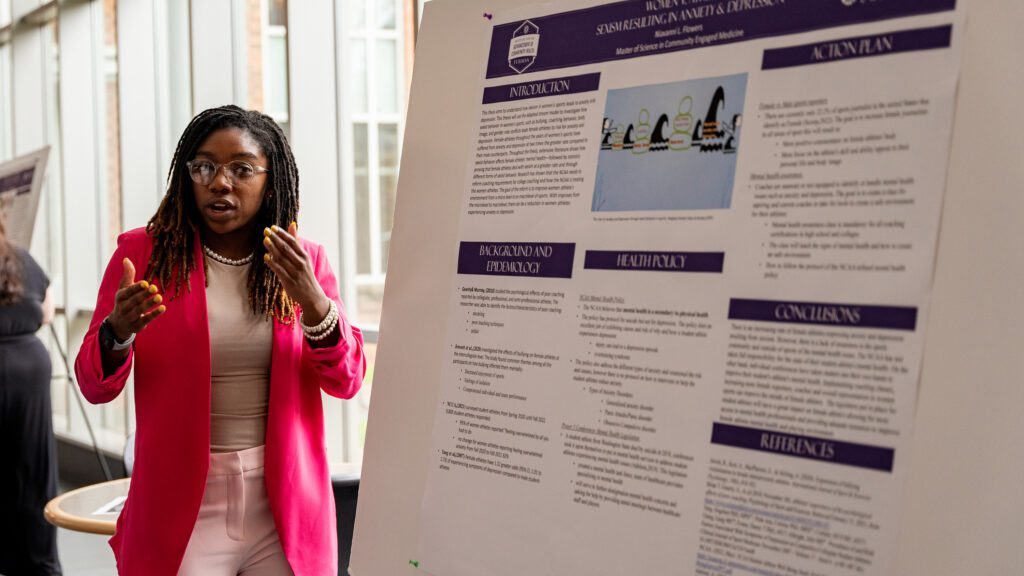
Community engaged medicine graduate student Niavanni Flowers explains her work on the effects of sexism on female athletes’ mental health.
How’s the weather?
Most of us rely on weather forecasts to make day-to-day decisions. Forecasts dictate what we wear, whether we bring an umbrella to class or work, or what the day looks like for outdoor activities. That simple reality is part of why computer science majors Ian Cho ’24 and Luke Kvamme ’23 chose this line of research.
“Having accurate weather forecasts is something that everyone can relate to,” Kvamme said. “It made the research more fun and interesting to complete.”
They wanted to know just how reliable those weather professionals are and how their prognostications compare to those of amateurs, among other questions, for their research topic.
Using Python, the two compiled and analyzed data and forecasts from 11 sources across 61 major cities in the U.S. and Canada, collected twice a day for five years. That amounts to more than 400K html files equaling to about 125 GB of text data.
When comparing forecasts to actual recorded temperatures, the researchers found that TV meteorologists are pretty accurate. What surprised Cho and Kvamme was that weather-savvy amateurs aren’t too far off from the predictions of their network counterparts. The amateurs were only off by about 2.5 degrees in their forecasts compared to the professionals.
Alongside the best
To Charlie Smith ’25, the black dots and lines on the screen in the Herring Music Pavilion sounded just like trumpeter Jason Palmer improvising during a performance of the Dizzy Gillespie jazz classic “Con Alma.”
The sophomore trumpet performance major had spent “hours, days, weeks – as long as it took” listening to a recording of Palmer’s solo to get the notes down on paper for a Summer 2022 research project.
Smith and 12 other student musicians shared their summer experiences during the “Engaged Learning in Music” session at Furman Engaged, chaired by Grant Knox, an associate professor of music. Many had spent their summers developing their skills in some of the world’s most prestigious music festivals and programs.
They described learning advanced techniques to record percussion instruments; touring the country with the Cadets Drum and Bugle Corps, “a marching band on steroids;” singing arias with the Chicago Summer Opera; and playing the music of Gustav Mahler in the composer’s hometown in the Czech Republic during the Prague Summer Nights festival.
At the Aspen Music Festival and School, percussionist Will Harris ’23 played Prokofiev, Bach and Beethoven in concert right alongside the world-class musicians and instructors.
“It was the highest form of engaged learning you can imagine,” he said, “being able to perform and get coaching at the same time.”

The poster session in Timmons Arena
A sculpture about trash, a card for a bad haircut
Greeting cards to commemorate birthdays, anniversaries and other major life events are easy to find. But what can you send a friend who has lost their phone, or is struggling to adjust to a new haircut – or just plain having a bad day?
Rebecca Cowles ’23 might have you covered. For her senior capstone project, the studio art major created “The Small Things,” a line of watercolor greeting cards you won’t find at Hallmark – yet. She showed slides of her work during a Furman Engaged session of senior presentations in Roe Art Building, chaired by Michael May, an associate professor of art. Five seniors gave talks about their work on display in the gallery.
Noah Henderson ’23 used six charcoal drawings to reflect on the mental health of athletes – something the Paladin redshirt tight end, whose “love for football slowly began to fade away,” knows firsthand. One drawing shows a player cradling his head in his hands in the locker room; in another, an athlete is being berated by a coach during a game.
Hope Kvamme ’23 created sculptures depicting the plight of endangered animals, such as an orangutang clutching a blanket made of the trash endangering its habitat. But the artist faced struggles of her own with that piece.
“It was not particularly easy getting him into the kiln,” she said. “He was quite heavy.”
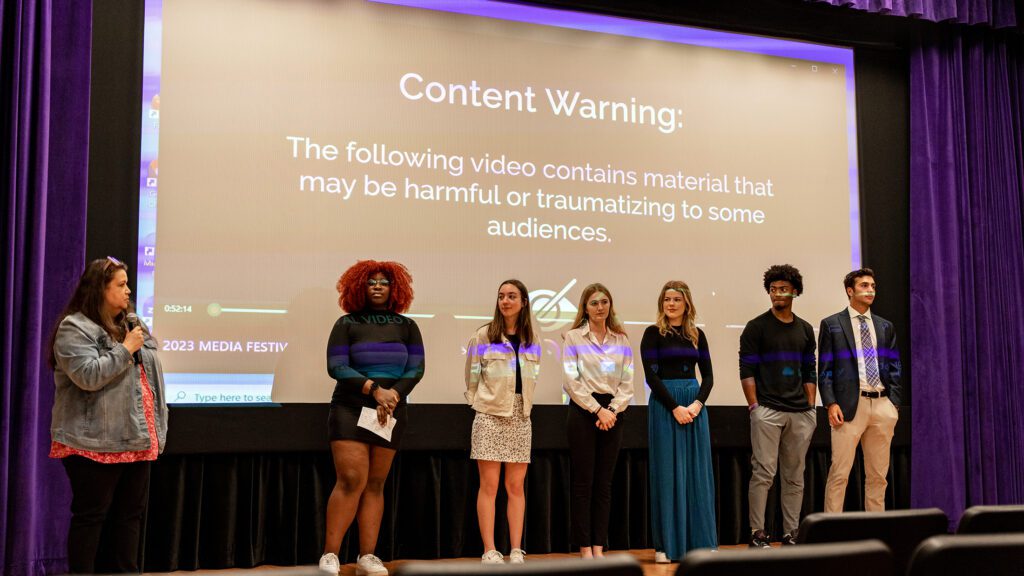
At left, Mary Sturgill, media specialist and communication studies instructor, with students during the Media Festival session
Trees, please
Senior sustainability science majors Patrick Flagler and Josephine Geraghty explored inequities associated with trees, or the lack thereof, for their presentation “Using Land Surface Characteristics, Census Data and Justice40 Criteria to Identify Neighborhoods of Interest for Trees Upstate.”
Underpinning their research is the Carolinas Collaborative on Climate, Health, and Equity, a NOAA CAP/RISA team aimed at building capacity for climate resilience for lesser-served communities. In Spartanburg, Flagler and Geraghty looked at urban heat islands, a phenomenon stemming from the lack of vegetation, or from the abundance of impervious surfaces such as asphalt or concrete often found in low-income areas.
Using satellite and census data, the researchers mapped tree canopy associated with neighborhood boundaries and identified 13 disadvantaged areas within the city, according to Justice40 guidelines. One of the at-risk neighborhoods showed land surface characteristics as more than 45% impervious – a prime spot for an urban heat island where temperatures can top 100 degrees, leading to health concerns, said Flagler.
From there, they drafted recommendations for the city and for Trees Greenville: Work with American Forests to receive a tree equity score; engage directly with communities to understand residents’ concerns; and develop plans to plant trees in areas of need. They plan to apply for a C3HE grant to plant trees in parts of Spartanburg.
Sermons under scrutiny
Sabrina Strickland-Harris ’24 and Virginia Wayt ’23 spent last summer studying what members of the clergy were telling their congregations after the Unite the Right rally in Charlottesville, Virginia, in 2017 and the killing of George Floyd in 2020.
Their research involved transcribing, coding and analyzing dozens of recorded sermons from around the time of those events. In the preliminary findings they presented during Furman Engaged, they found that many of those sermons tended to frame controversial issues as individual spiritual problems, not systemic social ills.
“Clergy have regular opportunities to share messages about race and racism to an audience,” said Wayt. “They are engaging with current issues, but they’re doing so really vaguely.”
Other presentations were made by students in visiting sociology professor Claire Gilliland’s two-part Methods of Social Research course. They brainstormed their quantitative research projects while learning research methods in Fall 2022. The students then spent this spring learning how to use statistical tools to analyze the data they gathered on topics like environmental action, mental health and social media, and the experience of brotherhood and sisterhood among fraternity and sorority members.
“They’re engaging in the full research process,” said Gilliland. “I’m really proud of how they shared their findings in accessible ways, so that a wide audience can understand.”
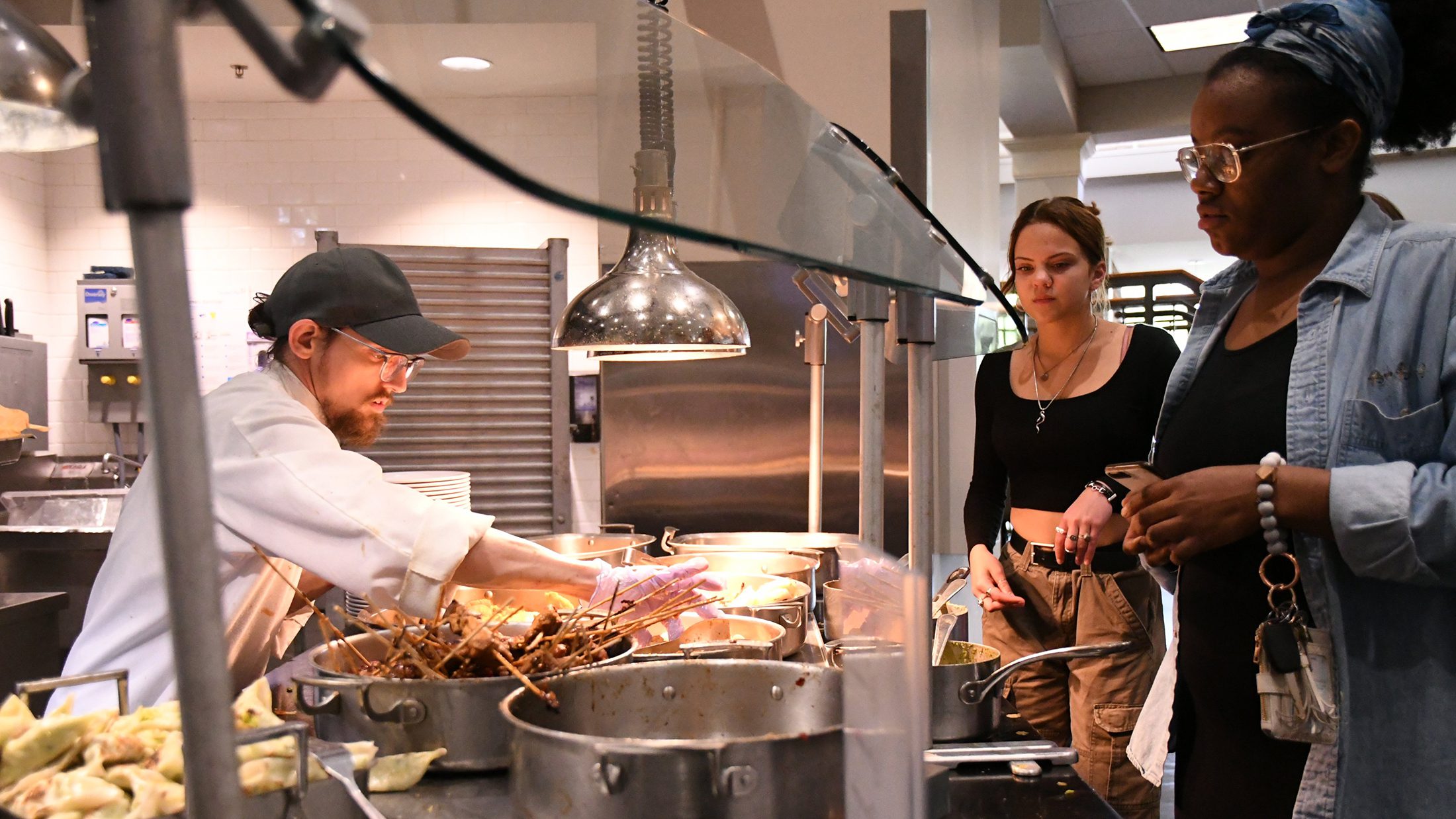
Students wait to be served during the International Food Festival, hosted by the Furman University International Student Association in the Dining Hall. The event, informed by Furman students, featured recipes from Kosovo, India, Kazakhstan and other countries.
New friends, new independence
In May 2022, business and accounting professors Marion McHugh and Robert Underwood piloted a three-week May Experience called “Czech Republic — From Soviet Domination to Flourishing Democracy.”
Students from the trip spoke about the experience on a Furman Engaged panel. Twenty students had gone on the MayX, and many, including economics major Katie Grzeszczak ’24, attended the session.
“I made amazing friendships and connections with all of my peers, and to this day, we all stay in contact as a group,” she said. “What stands out to me was the amount of things we’re able to do in such a short time — day excursions, tours of the city, lectures,” she said, adding that the group visited six firms.
Economics major Connor Shoemaker ’23 learned about the Velvet Revolution and was awed by the Museum of Communism as well as centuries-old architecture. Other students remembered tours of Prague Castle and the Jewish Quarter, a field trip to UNESCO World Heritage site Kutná Hora, and a visit to brewery Pilsner Urquell.
“Those three weeks were some of the best weeks of my life,” Shoemaker said.
“The MayX was truly the most memorable thing I’ve done at Furman,” said Grzeszczak. “On the flight home, I felt more independent, cultured, and realized I gained 21 new friends.”
Sarita Chourey, Jerry Salley ’90 and Tina Underwood contributed.